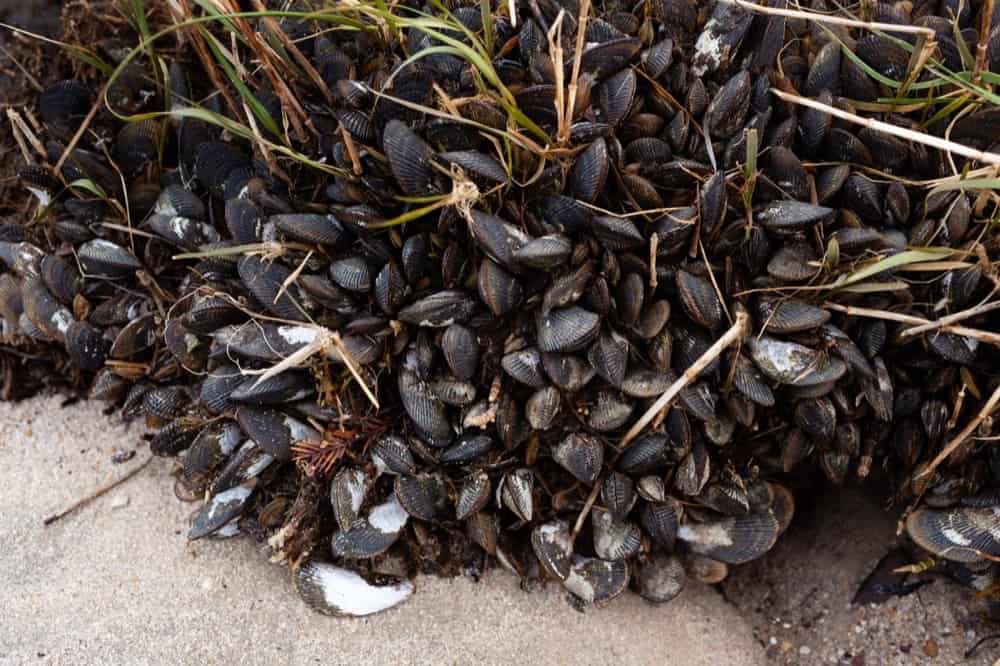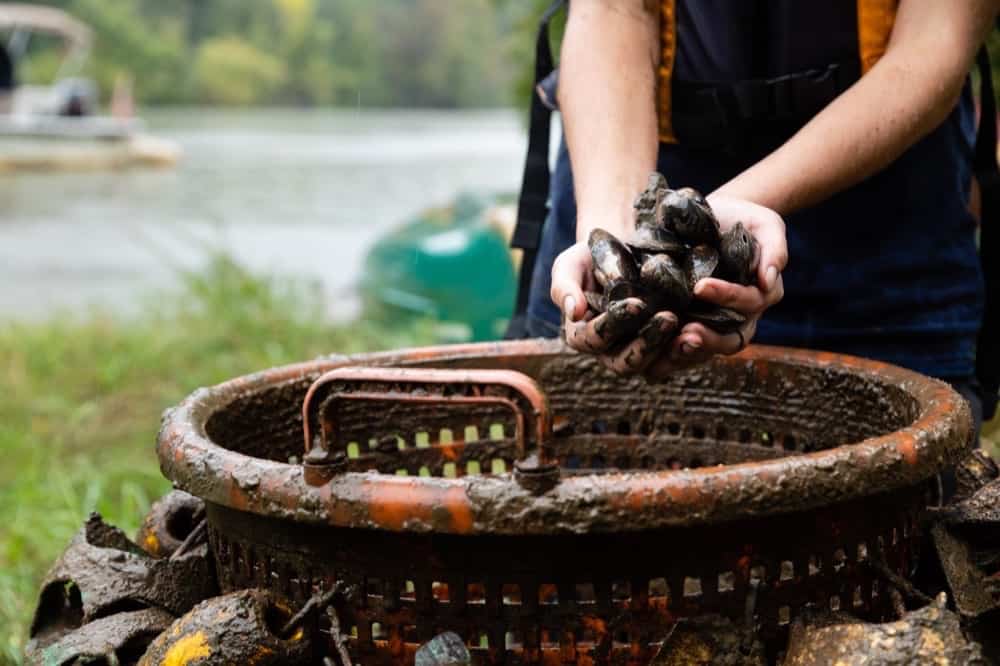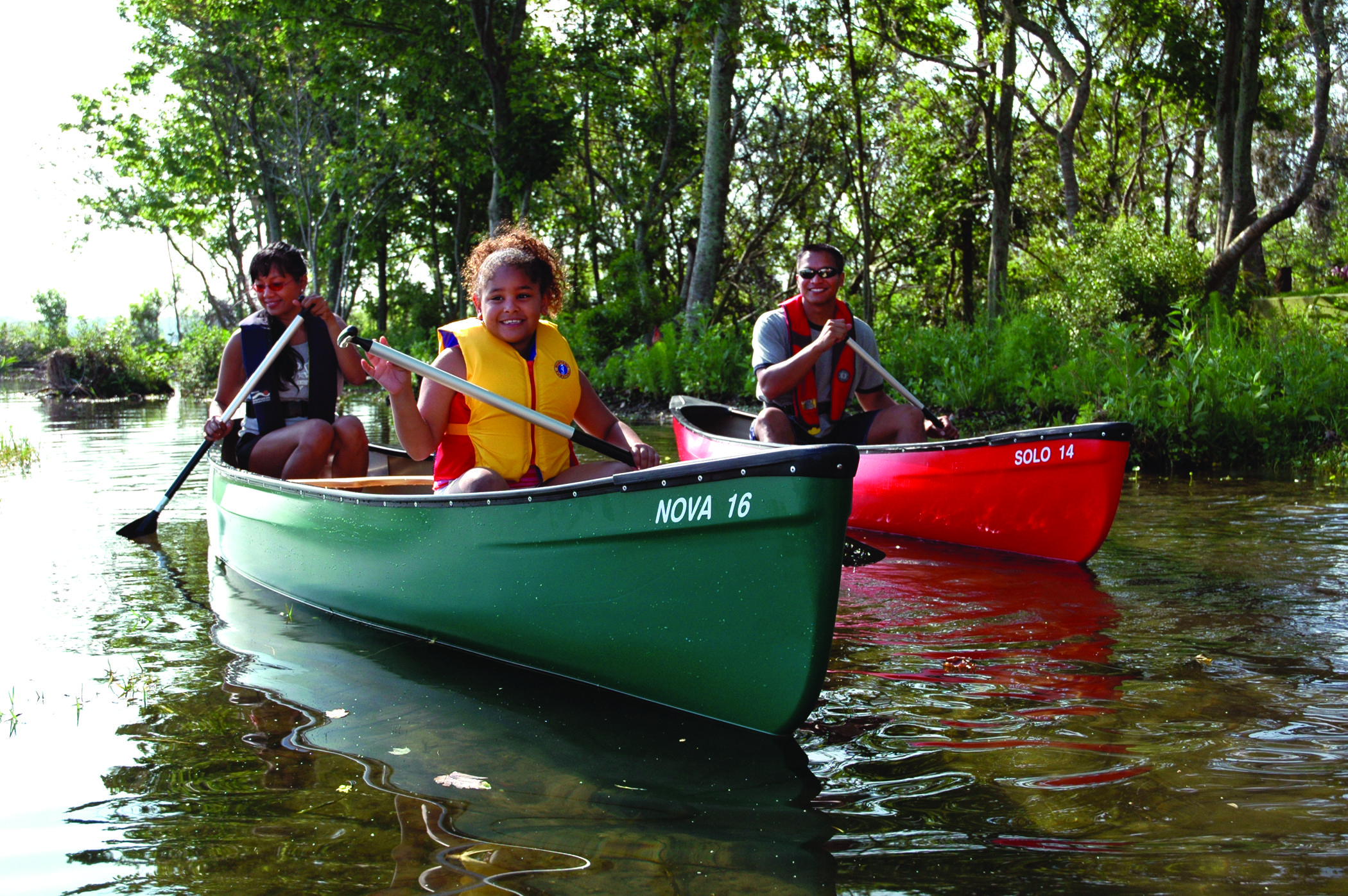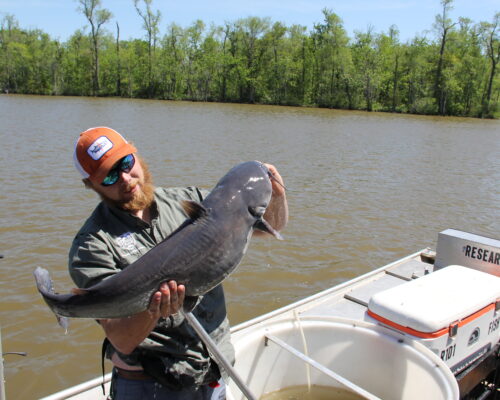Celebrating the Bay’s Laziest ecosystem engineers
By John Page Williams
“Don’t try to anchor there,” said the man standing on the barge. “There’s all kinds of junk down there that’ll hang it up, old refrigerators, rusty I-beams, scrap concrete full of rebar, whatever. You can tie up here.” In those days, 35 years ago, the barge served as a James River tour boat’s wharf at Rocketts Landing in downtown Richmond. I had just run Noel C., a Chesapeake Bay Foundation workboat, up from Hopewell for a special event. That was near the end of more than a century of abuse that the James endured from my native city. “Out of sight, out of mind; let the river take it away,” was the mantra from both Virginia’s capital and upriver.
Except that there was no away. Sooner or later, whatever got dumped, from steel to invisible chemicals, runoff, and upriver sediment, stayed put or traveled somewhere else. What was dissolved or suspended moved downriver, before settling or feeding algae blooms. Heavy stuff like the concrete and refrigerators stayed put. Either way, it accumulated somewhere, seriously damaging the river ecosystem.
Fortunately, that damage wasn’t the end of the story. Today the James River is gradually recovering. Last year, it won a prestigious international river prize. Happily, most of the Chesapeake’s other urban rivers and harbors are recovering too, albeit slowly. Now we are able to think about how they worked ecologically and restore the natural systems that our forebears trashed without realizing the damage they were causing.
Since it began in 1983, the Chesapeake Bay Program partnership has focused on living resources, especially wetlands and underwater grass beds (submerged aquatic vegetation). We call them keystone communities, because they form fundamental operating elements of the Chesapeake ecosystem. In the Bay and the lower rivers, restoration has also focused on oyster reefs, for their water filtration and the habitat they provide. We tend to attach special status to Bay creatures that offer direct benefits to us, and oysters fit the bill, to the point that many of us have begun growing them not only for food but also for the obvious benefits their reefs provide. They become pets, lovingly tended living rocks, in cages at private and public piers.
But oysters aren’t the Chesapeake’s only living rocks, and their reefs weren’t the only live bottom communities in the Chesapeake when Captain John Smith explored it 400-plus years ago.

The bottom eventually receives all the living material that live in or fall into the water above it. Scavengers like blue crabs and their mud crab cousins (about twenty species in our Bay system) pick up the larger bits from the bottom, but the Chesapeake’s many filter feeders catch the small-to-tiny-to-microscopic fragments more efficiently. In general, they pass or pump streams of water over catchment structures in their bodies, straining out anything digestible and moving it into their intestinal tracts for absorption.
Nature has developed multiple effective designs for filter-feeding. Some of the most successful are bivalve mollusks, animals with paired shells of hard calcium derived from the surrounding water. They have flexible hinges and strong internal muscles to clamp the two shells tightly when threatened. They pump water through their gills, catching algae, bacteria, suspended decaying plant and animal material, and fine sediment, improving water quality and packaging sediment in mucus so it settles out instead of continuing to cloud the water column.
These are our living rocks—hard-shelled and seemingly inert chunks of mineral. Our beloved oysters are obviously members, and so are the three species of mussels—hooked, ribbed, and dark false—that we find on oyster reefs, marsh banks, and dock pilings. Although individual mussels don’t filter as much water per day as oysters do, they make up the difference in their huge numbers. They also feed fish, crabs, birds, and mammals like river otters, muskrats, and raccoons.
All of these hard-shell critters are found in salty or brackish water. The Chesapeake’s headwater streams, creeks, and rivers benefit from living rocks, too.
In tidal freshwater and above the tide lines, great variations in stream environments throughout the Chesapeake and Susquehanna watersheds have allowed an array of freshwater mussel species to develop. “Mussel” is something of a misnomer for these shellfish, because they bury in stream bottoms more like clams. Pennsylvania lists 12 species with colorful names like elktoe, brook floater, and rainbow. Maryland houses 18 species, including some on Pennsylvania’s list, plus eight species it shares with the District of Columbia’s Anacostia River. Virginia’s Chesapeake drainage grows a dozen, including alewife floater, tidewater mucket, and James River spinymussel. They benefit their streams through their appetite for whatever their waterways give them. In turn, they feed channel catfish, river mammals, and herons. Their rough bottom beds create habitat for insect larvae and tiny fish that also feed on organic material and provide food for predator fish. Once established, these shellfish live in their beds for amazing stretches of time—50 to 100 years.
Buried in stream bottoms with one-way, downstream flow, these mussels face difficulty spreading their young. Oysters, living in tidal waters that move back and forth, broadcast their spawn for tide and wind to disperse. Freshwater mussels, meanwhile, employ their streams’ fish communities to spread their larvae. Some infect multiple species of fish; others specialize in one or two kinds of host.
First, a female mussel draws in sperm emitted by nearby males, fertilizing the eggs inside her. The larvae develop in a sac, which she allows to hang outside her shell when they reach appropriate size. This sac can take a detailed shape, designed to lure a specific fish variety to bite it. In fact, lure is the operative word. To attract a predator like a smallmouth bass, the sac may be shaped like a minnow, even down to an eyespot, a stripe or two, and a forked tail that waves in the current. Other, less specific lures may simply be worm-like projections that loosely simulate insect larvae or
other stream invertebrates that sunfish or catfish eat, or a spider-like web of larvae-filled mucus strands through which river herring or shad might swim.
Once the fish strikes and breaks the lure or web, glochidia (parasitic larva) attach to its gills, fins, or skin with trap-like mouths, some including tiny hooks. The fish’s skin grows over these little hitchhikers, turning them into cysts. They grow as parasites that cause minimal damage, then drop off wherever the fish has taken them, creating new areas of live bottom.
The long-distance prize for these relationships in the Chesapeake lies between eastern elliptio mussels and American eels in the Susquehanna River. There the eels historically carried mussel larvae several hundred miles, all the way to Otsego Lake above Cooperstown, New York. Thus, they helped build mussel beds all along the way in the big river’s main stem and many branches.
Dams built along the river over the past century-and-a-half, however, have blocked most eels, causing both eels and mussels to crash. We’ve also disrupted too many stream environments with debris like the anchor-fouling junk I found at Rocketts Landing, plus sediment, oils, and other harmful materials that never really go away. Several native species are threatened or endangered. Any harvest of freshwater mussels in the Chesapeake watershed is prohibited, even for bait.
Today, however, a major effort seeks to improve eels’ access to the Susquehanna River system and to infect them with elliptio mussels. Elsewhere, staff and volunteers from the Anacostia Watershed Society are actively restoring beds in that now-recovering river. Laboratories rearing mussels for reintroduction include Maryland DNR’s Joseph Manning Hatchery, and the Harrison Lake National Fish Hatchery on the James in Charles City, Virginia. Some James spinymussels grown at Harrison Lake are already building new beds in the James near Rocketts Landing and elsewhere.
The ways these mussels intricately weave together the living communities in their unseen worlds has major advantages for water quality, stream flow, and ecosystem health, both in upland streams and in tide just below. No wonder scientists refer to them respectfully as ecosystem engineers. Who knew? Both saltwater and freshwater mussels have been unobtrusively playing key ecological roles for centuries. Maybe our streams, creeks, and upper rivers need mussel beds just as much as our tidal waters need live bottom oyster reefs.




